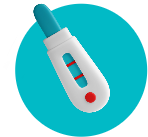
Pregnancy calculator

This calculator helps you determine your due date based on the date of your last menstrual period.
Pregnancy begins from the first day after fertilization, and fertilization occurs in the last section of the fallopian tube, and the fertilized egg grows to go through several stages during the days following fertilization. after fertilization. Pregnancy does not have to last a full 40 weeks or 280 days, as the duration of pregnancy varies greatly from one woman to another with many different factors.
At the beginning of pregnancy, some symptoms and changes appear that may indicate pregnancy, and the cause of these symptoms is the hormonal changes that usually accompany pregnancy. Symptoms of pregnancy include:
Pregnancy continues until the fetus's organs are fully developed and able to live outside the womb, and most importantly is the maturity of the lungs and the child's ability to breathe spontaneously and naturally.
The duration of pregnancy and the rate of fetal growth vary depending on a number of factors, including:
Some cases that threaten the life of both the mother and the fetus may require early termination of pregnancy by caesarean section, and the most prominent of these cases include:
Pregnancy changes are usually not serious, but are normal and not associated with any problems, and may be associated with minor and low-risk problems, in most cases. When appropriate equipment and quality care are available in the incubators and children's departments in health centers, the child is able to live at birth at the age of 25 weeks if a cesarean section is required before the full term of pregnancy, but this depends on the development and efficiency of the equipment in the place of birth.
At the beginning of pregnancy, some symptoms and changes appear that may indicate pregnancy, and the cause of these symptoms is the hormonal changes that usually accompany pregnancy. Symptoms of pregnancy include:
- Absence of a period: It is the first sign of pregnancy when a period is absent and does not occur at the expected date and for a week after it in a woman of childbearing age, it is likely that this is one of the signs of pregnancy
- Breast swelling and engorgement: The rise in female hormones during pregnancy causes engorgement, tenderness and an increase in breast size
- Nausea, vomiting, and dizziness: It is one of the most common symptoms of pregnancy, as morning vomiting begins during the first month of pregnancy, and vomiting can occur during any time of the day and as a result of any reason.
- Fatigue: Rapid fatigue is one of the symptoms of pregnancy as well. This includes an increase in the number of hours of sleep during the first trimester of pregnancy and rapid fatigue when doing daily activities and chores. The reason is not known precisely, but hormones are the most contributing to the occurrence of fatigue during pregnancy.
Pregnancy continues until the fetus's organs are fully developed and able to live outside the womb, and most importantly is the maturity of the lungs and the child's ability to breathe spontaneously and naturally.
The duration of pregnancy and the rate of fetal growth vary depending on a number of factors, including:
- Maternal age: The incidence of problems leading to premature termination of pregnancy and childbirth increases when the mother is over 35 years old or under 18 years old.
- The number of previous births: The probability of termination of pregnancy before 40 weeks is greater in the first pregnancy and in cases of more than 4 previous births.
- Maternal weight before pregnancy: Underweight or obese women before pregnancy lead to premature birth.
- Nutritional status: Malnutrition in the mother leads to a lack of intrauterine growth of the fetus and a delay in the date of delivery. Disruption of nutritional factors in some cases leads to premature birth.
- Hormones: Hormonal imbalance may lead to premature birth or pregnancy-related problems that require pregnancy termination and caesarean delivery.
- Genetics: Genetics factors determine the duration of pregnancy and the rate of growth of the fetus inside the womb, and thus contribute to determining the date of birth.
Some cases that threaten the life of both the mother and the fetus may require early termination of pregnancy by caesarean section, and the most prominent of these cases include:
- Preeclampsia: It is a state of severe high blood pressure with coma and unconsciousness, in addition to failure of the kidneys, heart and other organs.
- Pre-eclampsia: Also called pre-eclampsia or pre-eclampsia, it is a stage before pre-eclampsia and during which severe high blood pressure occurs with other general symptoms without organ failure or lack of awareness.
- Early labor: Labor for natural childbirth may begin early in some cases, and this labor can be stopped and the birth postponed for a few weeks, during which the mother remains under observation, but stopping labor may fail in some cases, which necessitates early birth.
Pregnancy changes are usually not serious, but are normal and not associated with any problems, and may be associated with minor and low-risk problems, in most cases. When appropriate equipment and quality care are available in the incubators and children's departments in health centers, the child is able to live at birth at the age of 25 weeks if a cesarean section is required before the full term of pregnancy, but this depends on the development and efficiency of the equipment in the place of birth.
Treatment Services
In the Best Medical Centers
Contact Us
Please fill the form below and describe your condition, We will contact you back
Select Service
- Dental Treatment
- Hair Transplant
- Obesity Surgery
- Vision Correction
- Health Resorts
- Other Medical Services
- No elements found. Consider changing the search query.
- List is empty.
Your personal data is processed as indicated in the general statement text and by continuing, you explicitly consent to the processing

